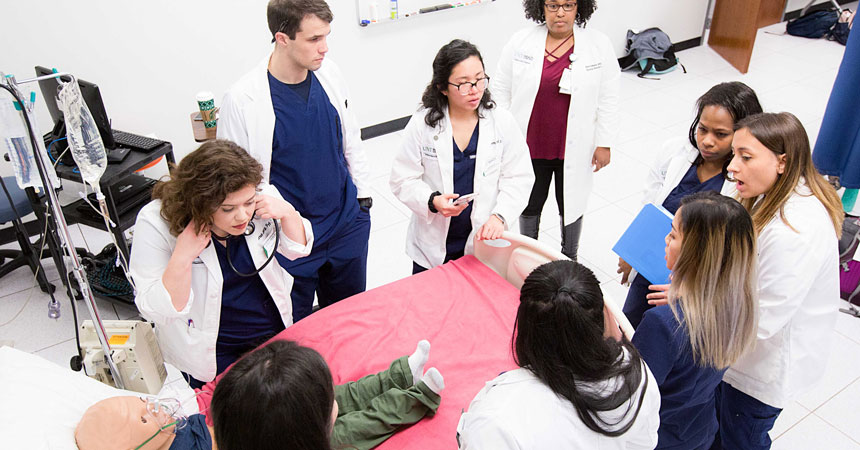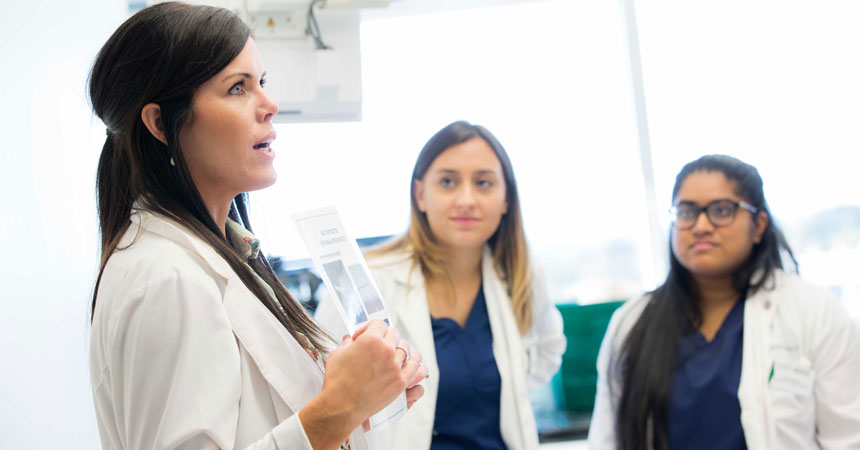The evolution of the physician assistant
By Alex Branch
To understand why physician assistant is one of the hottest jobs, meet Victoria Florez.
She fielded four job offers before she even graduated last year from the UNT Health Science Center Physician Assistant (PA) Studies Program.
Each offer was from a different specialty. Did she want to work in plastic surgery, wound care, critical care or primary care?
The starting salaries were competitive – and the national median salary for a PA with zero to one year of professional experience in 2018 was more than $100,000.
Florez eventually joined a primary care clinic in Burleson, working a 9 a.m. to 6 p.m. weekday schedule, with time for yoga, Pilates and evening dance lessons with her husband.
“The relationships with our patients are fulfilling because as a PA you really get to know them and their families,” Florez said. “The quality of life is great. And most of my classmates found exactly what they wanted to do as well.”
The physician assistant field is booming. Created in the 1960s, the profession today is one of the most desired jobs in the country, ranking third in the U.S. News and World Report list of the Best Jobs in 2018.
Young people, attracted by the work-life balance, salary and flexibility to move between specialties, are flocking to nationally recognized PA programs like the one at UNTHSC. Instead of spending between seven to 10 years in medical school and residency training like physicians, PAs can be licensed to care for patients in less than three years.
As the popularity surges, so does the competition. The number of applicants for the 75 first-year spots in UNTHSC’s program increased from 593 in 2011 to 1,919 in 2017.
“Not terribly long ago, a good percentage of physician assistants were slightly older people who had previously held other jobs in medicine and did this as a second career,” said Kirk W. Barron, PhD, PA-C, Chairman of the Physician Assistant Studies Program “Today, new college graduates are recognizing that physician assistant is a viable, very rewarding career. The profession has come a long way.”
Origin of the specialty
In 1965, U.S. Navy Hospital Corpsman Ken Ferrell, 21, stood aboard the USS Ashland warship in the Caribbean and studied a letter he had received from a friend.
The friend had read a newspaper story about Dr. Eugene Stead Jr., who was recruiting students for a new educational program at Duke University. The program would train people for a new position in health care – the “physician assistant,” he called it.
The physician assistant, or PA, was intended to combat a shortage of primary physicians. Dr. Stead described the physician assistant as “extending the arms and legs of the physician.”
Dr. Stead had first imagined firefighters as candidates for the program but soon realized Navy corpsmen and U.S. Army medics were returning from the Vietnam War with valuable medical skills.
“It seemed so practical,” Ferrell said. “I had been treating sailors for everything from sore throats to injuries from accidents on the ship. I was absolutely interested.”
The first class of PA students – four Navy corpsmen, including Ferrell — started classes at Duke University in fall 1965. One would drop out.
Two years later, Ferrell graduated and got hired by a busy internal medicine physician in Durham who saw 30 patients a day. Patients reacted to Ferrell with confusion. “You’re a what?” they asked.
“Patients had never seen someone like me,” Ferrell said. “But they seemed to realize quickly that I could handle all of the things that didn’t require a doctor’s training to do. Soon the patients and nurses would call me instead of the doctor because they knew they could reach me faster.”
Ferrell worked as a PA for 47 years. He is the only surviving member of the first class of PAs. One died of a heart attack at age 31 shortly after graduation. The other, Vic Germino, died last year after a long career as a PA.
Ferrell and Germino stayed in touch, marveling that their experimental four-member class had grown into more than 250 PA programs nationwide.
“Did we think it would become this?” Ferrell said, laughing. “Not in our wildest dreams!”
Freedom to change
The first class of PAs at UNTHSC was bigger than Ferrell’s class, but not by much.
In 1997, 12 students started the Fort Worth program, created under the supervision of founding director Hank Lemke, DHSc, PA-C.
Today, the program accepts 75 students each year and has 765 graduates.
The program emphasizes primary care and meeting the needs of underserved communities in Texas. More than 70 percent of PA graduates leave UNTHSC with an interest in primary care, according to surveys.
PAs are increasingly found working in specialty fields. Among the many specialties offered to UNTHSC students on clinical rotation are emergency medicine, pediatrics, psychiatry, surgery and women’s health.
Tamara Willmoth, a 2012 PA program graduate, worked first in the gastrointestinal field and then emergency medicine before returning to UNTHSC as an Assistant Professor.
“I was able to get four job offers just from places I spent time on rotation,” Willmoth said. “They had never had a physician assistant before and would say, ‘You did a good job. We’ll wait for you to graduate.’
“That’s why we tell students now to approach every rotation in every specialty like it’s a job interview.”
If a physician wants to change specialties, he or she must go through an often time-consuming process to get certified in a different specialty. PAs simply get hired and train on the job.
“A physician assistant can work in pediatrics for five years, work in surgery for five years and work in primary care for five years,” said Lauren Dobbs, MMS, PA-C, UNTHSC Associate Professor of Physician Assistant Studies. “The freedom to move swiftly between specialties is a big draw to the field.”
Proven abilities
Even though PAs have existed for a half century, their acceptance in the medical community has grown exponentially in the last 20 years.
“I started as a PA in the early 2000s at a pediatric clinic for indigent patients in a South Texas community, and it wasn’t easy,” said Juliann Castillo, PhD, UNTHSC Associate Professor of Physician Assistant Studies. “I faced some skepticism from the medical community and had to prove my knowledge and abilities.”
But skepticism has faded. Willmoth was the first PA hired to work in the emergency department at a hospital in Arlington. Four years later, 13 PAs work there.
“At the Health Science Center, our student PAs train with our medical students,” Willmoth said. “They are comfortable working as a team, and our medical students recognize our PAs’ abilities. As our medical students go on to become doctors, they are eager to hire PAs.”
Jenna Oropeza, MPAS, PA-C, a May 2018 graduate who now works in surgical oncology at Parkland Memorial Hospital in Dallas, said two fellow alumni also recently landed jobs in medical oncology and gastrointestinal surgery at the hospital.
“The Health Science Center’s PA program is like a family,” she said. “It’s supportive, and the program’s training rotations are great experiences. I think employers know they are getting high-quality PAs.”
Though the PA program is consistently ranked among the best in the country by U.S. News and World Report, program officials continue to refine it. The curriculum shortened this year from 34 to 30 months to improve efficiency, and students now spend every Friday in a collaborative clinical setting instead of classroom lectures.
Florez, the business major turned PA, said she had no regrets about turning down business job offers after undergraduate school to enter the UNTHSC program.
“The PA program is intense; it is a few of the hardest years of your life,” she said. “But the opportunities waiting afterward are very much worth it.”









Social media